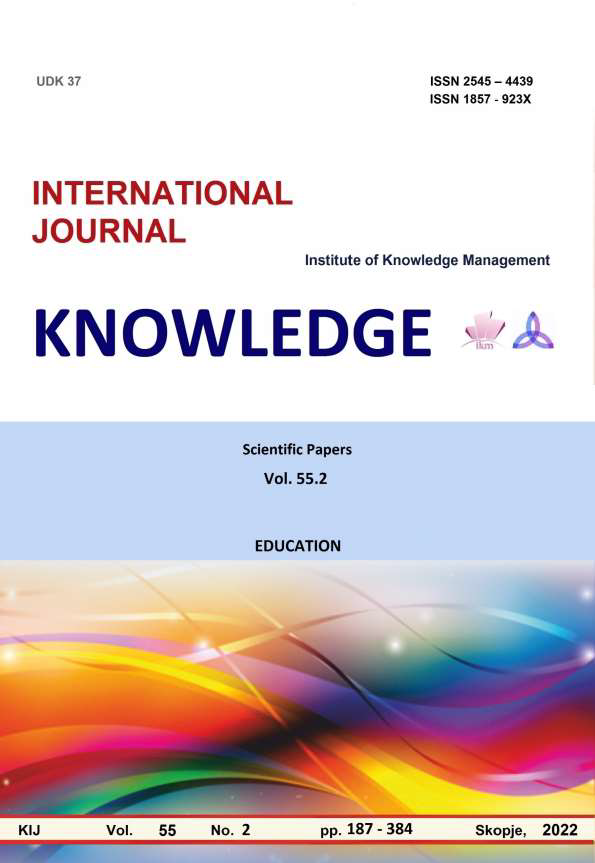THE CONCEPT OF ENGLISH FOR SPECIFIC PURPOSES AS AN APPROACH TO LANGUAGE TEACHING
Keywords:
English for Specific Purposes, ESP definitions, types of ESP, characteristics, methodologyAbstract
The period following the Second World War has brought immense changes on the economic, political
and social levels. The ever-growing levels of globalization, tremendous and continuous progress in science and
technology, the development of the world’s economy and internalization of higher education have resulted in
people's increased awareness of the importance of successful cross-cultural communication and collaboration as
major components of workplace dynamics in a globalized world. Thus the knowledge of English, a global lingua
franca, has opened new perspectives for mobility and cooperation in all spheres of human activity. Countries
worldwide have recognized the importance of the English language and included it in the curricula at all levels of
education. Due to the fact that each profession has its own context, terminology and the manner in which it
communicates its ideas, General English courses have frequently failed to respond to learners’ or employers’ needs.
The recognized demand for teaching and learning English tailored to the specific needs of learners’ instead of
traditionally focusing on teaching language forms, has led to the emergence of English for Specific Purposes (ESP),
an approach to language teaching related to the specific purpose for learning English and addressing learners ever
growing needs and requirements resulting from labor market demands, and its separation from the concept of
General English. Since the 1960s, ESP has grown to become one of the most prominent areas of English as a
Foreign Language (EFL) teaching. Its significance is reflected in an increasing number of universities worldwide
including ESP as a compulsory subject in their bachelor degree programs in different fields in order to meet their
students’ future career needs. The aim of this paper is to highlight the importance of ESP on a global level and
analyze its major aspects – its historical background, the theories that define it, the types of ESP, the characteristics
that distinguish it from English for General Purposes (EGP), as well as to consider some of the methodological
implications for language teachers.
References
Altun, M., & Ahmad, H. K. (2021). The Use of Technology in English Language Teaching: A Literature Review. International Journal of Social Sciences & Educational Studies, 8(1), 226–232.
Ayuningtyas, P. (2017). Using Authentic Materials in the ESP Classroom. Proceedings of the Conference on Language and Language Teaching – CLLT 2017, 107–113.
Basturkmen, H. (2006). Ideas and Options in English for Specific Purposes. Mahwah, NJ: Lawrence Erlbaum Associates.
Bojović, M. (2006). Teaching Foreign Language for Specific Purposes: Teacher Development. Proceedings of the 31st Annual ATEE Conference, 487–493.
Bolchover, D. (2012). Competing across borders: How cultural and communication barriers affect business. Economist Intelligence Unit. https://www.eiuperspectives.economist.com/sites/default/files/Competing%20across%20borders.pdf
Bracaj, M. (2014). Teaching English for Specific Purposes and Teacher Training. European Scientific Journal, 10(2), 40–49.
Carver, D. (1983). Some Propositions about ESP. The ESP Journal, 2, 131–137.
Crystal, D. (2003). English as a global language. Cambridge: Cambridge University Press.
Dudley-Evans, T., & St John, M. J. (1998). Developments in English for Specific Purposes: A multi-disciplinary approach. Cambridge: Cambridge University Press.
Duyen, L. T. H. (2014). Learning to Teach ESP: Case Studies of Two Vietnamese General English Teachers. Language Education in Asia, 5(2), 228–237.
Hutchinson, T., & Waters, A. (1987). English for Specific Purposes: A learning-centered approach. Cambridge: Cambridge University Press.
Javid, C. Z. (2013). English for Specific Purposes: Its Definition, Characteristics, Scope and Purpose. European Journal of Scientific Research, 112(1), 138–151.
Jendrych, E. (2013). Developments in ESP Teaching. Studies in Logic, Grammar and Rhetoric, 34(47), 43–58.
Jordan, R. R. (1997). English for academic purposes: A guide and resource book for teachers. New York: Cambridge University Press.
Lukač-Zoranić, A. (2013). Kultura i jezik u poslovnoj komunikaciji. Ekonomski izazovi, 3, 161–169.
Nădrag, L., & Buzarna-Tihenea, A. (2017). The benefits of using authentic materials in the ESP classroom. Case study. Diacronia, 28(1), 137–150.
Nguyen, A., & Tran, M. (2019). Science journalism for development in the global south: A systematic literature review of issues and challenges. Public Understanding of Science, 28, 973–990.
Paltridge, B., & Starfield, S. (Eds.). (2013). The Handbook of English for Specific Purposes. Chichester: Wiley-Blackwell.
Ramírez, C. (2015). English for Specific Purposes: Brief History and Definitions. Revista de Lenguas Modernas, 23, 379–386.
Ramirez-Castañeda, V. (2020). Disadvantages in preparing and publishing scientific papers caused by the dominance of the English language in science: The case of Colombian researchers in biological sciences. PLoS ONE, 15(9), 1–15. https://doi.org/10.1371/journal.pone.0238372
Robinson, P. C. (1991). ESP Today: A Practitioner’s Guide. Hemel Hempstead: Prentice Hall International (UK) Ltd.
Su, H. (2021). Innovation research on foreign language teaching theory with Chinese characteristics based on Whitehead’s process philosophy. Asian-Pacific Journal of Second and Foreign Language Education, 6, 18. https://doi.org/10.1186/s40862-021-00123-4
Thi, L., & Duyen, H. T. (2015). Learning to Teach ESP: Case Studies of Two Vietnamese General English Teachers. Language Education in Asia, 5, 228–237.
Van Weijen, D. (2012). The Language of (Future) Scientific Communication. Research Trends, 1(31), 7–8.
Voyakina, E. Y., & Korolyova, L. Y. (2014). To The Problem Of Teaching Business English as English for Specific Purposes In Higher Educational Institutions. УНИВЕРСИТЕТ им. В.И. ВЕРНАДСКОГО, 1(50), 47–55.
Web Technology Surveys. (2022, November 22). Usage statistics of content languages for websites. https://w3techs.com/technologies/overview/content_language
Widdowson, H. G. (1983). Learning Purpose and Language Use. Oxford: Oxford University Press.
Williams, C. (2014). The future of ESP studies: building on success, exploring new paths, avoiding pitfalls. ASp la revue du GERAS, 66, 137–150. https://doi.org/10.4000/asp.4616





